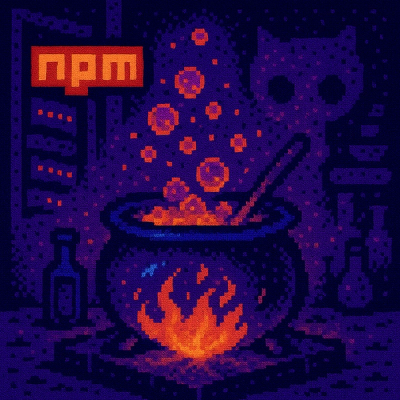
Research
/Security News
9 Malicious NuGet Packages Deliver Time-Delayed Destructive Payloads
Socket researchers discovered nine malicious NuGet packages that use time-delayed payloads to crash applications and corrupt industrial control systems.
@movable/cluster-master
Advanced tools
A module for taking advantage of the built-in cluster module in node
v0.8 and above.
Your main server.js file uses this module to fire up a cluster of
workers. Those workers then do the actual server stuff (using socket.io,
express, tako, raw node, whatever; any TCP/TLS/HTTP/HTTPS server would
work.)
This module provides some basic functionality to keep a server running. As the name implies, it should only be run in the master module, not in any cluster workers.
var clusterMaster = require("cluster-master")
// most basic usage: just specify the worker
// Spins up as many workers as you have CPUs
//
// Note that this is VERY WRONG for a lot of multi-tenanted
// VPS environments where you may have 32 CPUs but only a
// 256MB RSS cap or something.
clusterMaster("worker.js")
// more advanced usage. Specify configs.
// in real life, you can only actually call clusterMaster() once.
clusterMaster({ exec: "worker.js" // script to run
, size: 5 // number of workers
, env: { SOME: "environment_vars" }
, args: [ "--deep", "doop" ]
, silent: true
, signals: false
, onMessage: function (msg) {
console.error("Message from "+this.uniqueID+" "+msg)
}
})
// methods
clusterMaster.resize(10)
// graceful rolling restart
clusterMaster.restart()
// graceful shutdown
clusterMaster.quit()
// not so graceful shutdown
clusterMaster.quitHard()
Set the cluster size to n. This will disconnect extra nodes and/or
spin up new nodes, as needed. Done by default on restarts.
One by one, shut down nodes and spin up new ones. Callback is called when finished.
Gracefully shut down the worker nodes and then process.exit(0).
Forcibly shut down the worker nodes and then process.exit(1).
The exec, env, argv, and silent configs are passed to the
cluster.fork() call directly, and have the same meaning.
exec - The worker script to runenv - Envs to provide to workersargv - Additional args to pass to workers.silent - Boolean, default=false. Do not share stdout/stderrsize - Starting cluster size. Default = CPU countsignals - Boolean, default=true. Set up listeners to:
SIGHUP - restartSIGINT - quitonMessage - Method that gets called when workers send a message to
the parent. Called in the context of the worker, so you can reply by
looking at this.repl - where to have REPL listen, defaults to env.CLUSTER_MASTER_REPL || 'cluster-master-socket'
repl is null or false - REPL is disabled and will not be startedrepl is string path - REPL will listen on unix domain socket to this pathrepl is an integer port - REPL will listen on TCP 0.0.0.0:portrepl is an object with address and port, then REPL will listen on TCP address:PORTExamples of configuring repl
var config = { repl: false } // disable REPL
var config = { repl: '/tmp/cluster-master-sock' } // unix domain socket
var config = { repl: 3001 } // tcp socket 0.0.0.0:3001
var config = { repl: { address: '127.0.0.1', port: 3002 }} // tcp 127.0.0.1:3002
Note: be careful when using TCP for your REPL since anyone on the network can connect to your REPL (no security). So either disable the REPL or use a unix domain socket which requires local access (or ssh access) to the server.
Cluster-master provides a REPL into the master process so you can inspect
the state of your cluster. By default the REPL is accessible by a socket
written to the root of the directory, but you can override it with the
CLUSTER_MASTER_REPL environment variable. You can access the REPL with
nc or socat like so:
nc -U ./cluster-master-socket
# OR
socat ./cluster-master-socket stdin
The REPL provides you with access to these objects or functions:
help - display these commandsrepl - access the REPLresize(n) - resize the cluster to n workersrestart(cb) - gracefully restart workers, cb is optionalstop() - gracefully stop workers and masterkill() - forcefully kill workers and mastercluster - node.js cluster modulesize - current cluster sizeconnections - number of REPL connections to masterworkers - current workersselect(fld) - map of id to field (from workers)pids - map of id to pidsages - map of id to worker agesstates - map of id to worker statesdebug(a1) - output a1 to stdout and all REPLssock - this REPL socket'.exit - close this connection to the REPLFAQs
A helper script for managing a cluster of node worker servers
The npm package @movable/cluster-master receives a total of 25 weekly downloads. As such, @movable/cluster-master popularity was classified as not popular.
We found that @movable/cluster-master demonstrated a not healthy version release cadence and project activity because the last version was released a year ago. It has 7 open source maintainers collaborating on the project.
Did you know?

Socket for GitHub automatically highlights issues in each pull request and monitors the health of all your open source dependencies. Discover the contents of your packages and block harmful activity before you install or update your dependencies.

Research
/Security News
Socket researchers discovered nine malicious NuGet packages that use time-delayed payloads to crash applications and corrupt industrial control systems.

Security News
Socket CTO Ahmad Nassri discusses why supply chain attacks now target developer machines and what AI means for the future of enterprise security.

Security News
Learn the essential steps every developer should take to stay secure on npm and reduce exposure to supply chain attacks.